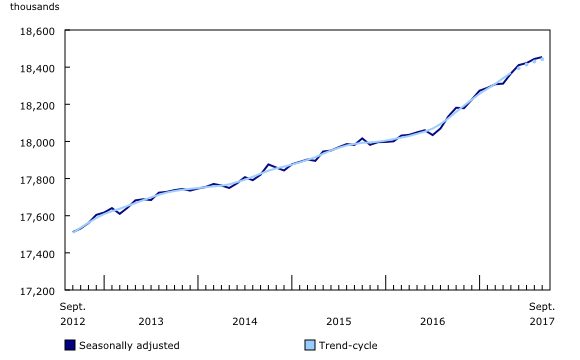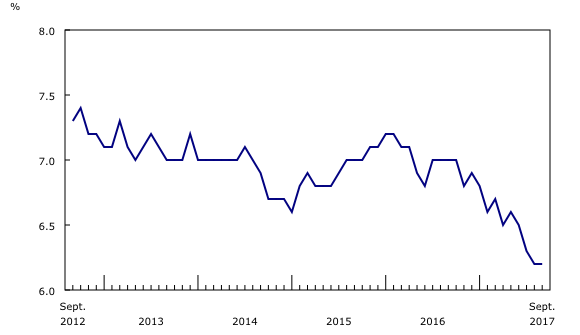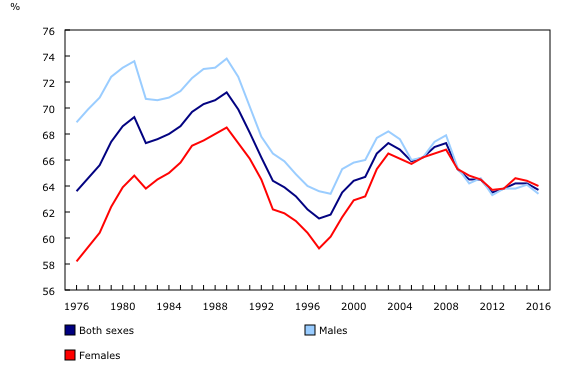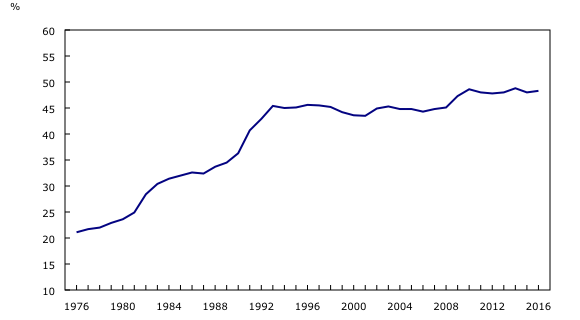Labour Force Survey, September 2017
Archived Content
Information identified as archived is provided for reference, research or recordkeeping purposes. It is not subject to the Government of Canada Web Standards and has not been altered or updated since it was archived. Please "contact us" to request a format other than those available.
Released: 2017-10-06
Employment was essentially unchanged in September (+10,000 or +0.1%). The unemployment rate remained at 6.2%, matching the low of October 2008.
Gains in full-time employment (+112,000) in September were mostly offset by declines in part time (-102,000). In August, there was a decline in the number of people working full time and an increase in part time.
In the 12 months to September, employment rose by 320,000 (+1.8%), spurred by gains in full-time employment (+289,000 or +2.0%). Over this period, the number of hours worked increased by 2.4%.
Overall employment grew by 43,000 (+0.2%) in the third quarter, slower than the 0.6% growth rate in the second quarter and the 0.5% growth rate of the first quarter of 2017.
Highlights
From August to September, employment increased for people aged 55 and older, while it fell among men aged 25 to 54.
For the second consecutive month, Ontario was the lone province with a notable employment gain. There were employment declines in Manitoba and Prince Edward Island.
More people worked in educational services as well as wholesale and retail trade in September, while employment fell in information, culture and recreation.
There was additional employment in the public sector, while the number of private sector employees was little changed. At the same time, the number of self-employed workers held steady.
More people aged 55 and older working
Employment rose by 25,000 in September for people aged 55 and older, mostly in full-time work. Their unemployment rate was little changed at 5.4%. Compared with 12 months earlier, employment for people aged 55 and older increased by 131,000 (+3.4%).
Among workers aged 55 and older, about 8 in 10 are between the ages of 55 and 64. The estimated year-over-year employment growth rate (unadjusted for seasonality) for 55- to- 64-year-olds was 2.6% in September and their population increased by 2.0%. While population growth was similar for men and women in this age group, employment grew at a faster pace for women (+3.5%) than for men (+1.8%).
In comparison, people aged 65 and older comprised a smaller share of older workers, but had the fastest year-over-year employment growth rate (unadjusted for seasonality) among the major demographic groups in September, rising 9.1% and outpacing their rate of population growth (+3.7%). Among this group of workers, employment grew at a faster pace for men (+12.4%) than for women (+4.5%). For more information about recent trends among older workers, see "The impact of aging on labour market participation rates."
Employment declines among men aged 25 to 54
For men aged 25 to 54, employment declined by 29,000 in September—all in part-time work. The unemployment rate for men in this age group rose by 0.4 percentage points to 5.9%. Compared with 12 months earlier, employment for men aged 25 to 54 increased by 72,000 (+1.2%).
Among women aged 25 to 54, full-time employment increased by 39,000 in September, while part time fell by 26,000, leaving overall employment for this group little changed. Their unemployment rate was 5.2%. Compared with 12 months earlier, employment among core aged women rose by 102,000 (+1.8%).
Youth unemployment rate down
Overall youth employment was little changed in September a 37,000 increase in full-time work was mostly offset by part-time losses. Employment for 15- to 24 year-olds was relatively unchanged compared with 12 months earlier. The unemployment rate for youth has been on a downward trend since the start of 2017 and fell 1.2 percentage points to 10.3% in September. This was the lowest rate since comparable data became available in 1976. See Chart 8 in the Labour Force Information publication.
The decline in the youth unemployment rate in September was due to fewer youths in the labour market. The participation rate for this group fell 0.7 percentage points to 62.7% in the month. At the same time, their rate of full-time school attendance was 56.4%—the highest rate for any September since 2011. Increased school attendance is associated with delayed labour market participation. For more information about this long-term trend, see the Canada 150 box "Evolution of youth in the labour market."
Provincial employment
In Ontario, employment rose by 35,000 in September, the fourth overall gain in five months. An increase of 78,000 in full-time employment was partly offset by a decline of 43,000 in part-time work. The overall employment increase in September was driven by gains in wholesale and retail trade as well as educational services. The unemployment rate was little changed at 5.6% in September. Compared with 12 months earlier, employment in Ontario was up 170,000 (+2.4%).
Employment in Manitoba declined by 5,500 in September, almost all in part-time work. This was the first notable overall employment decrease in the province since April 2016. Despite the monthly decline, employment in Manitoba has been on an upward trend since the end of 2016. In September, the unemployment rate increased by 0.6 percentage points to 5.5%.
In September, employment decreased in Prince Edward Island (-700), the second decline in three months. Despite the recent decreases, employment in the province was up by 1,600 (+2.2%) compared with September 2016. The unemployment rate increased by 0.7 percentage points in September to 9.5%.
Overall employment in Quebec was little changed for the third consecutive month. In September, a decline of 25,000 in part-time work was mostly offset by additional people working full time. In the 12 months to September, employment in the province rose by 54,000 (+1.3%), concentrated in full-time work. Over the same 12 month period, the unemployment rate fell by 0.9 percentage points to 6.0%.
Industry perspective
The number of people working in educational services increased by 20,000 in September, primarily in Ontario and Quebec. Employment in the industry was similar to the level observed in September 2016.
Employment in wholesale and retail trade rose by 17,000 in September, bringing gains to 99,000 (+3.6%) since September 2016.
Employment in information, culture and recreation decreased by 24,000 in September. On a year-over-year basis, employment in the industry edged down by 20,000 (-2.5%).
Public sector employment rose by 26,000 in September, while the number of private sector employees was little changed. Compared with 12 months earlier, the number of private sector employees increased by 162,000 (+1.4%) and public sector employment rose by 103,000 (+2.8%).
The number of self-employed workers held steady in September, with year-over-year gains totalling 55,000 (+2.0%).
Quarterly update for the territories
The Labour Force Survey collects labour market data in the territories, produced in the form of three-month moving averages.
In the third quarter of 2017, employment in Yukon was little changed compared with the second quarter, and the unemployment rate was relatively unchanged at 3.3%.
In the Northwest Territories, employment in the third quarter was unchanged from the previous quarter. Over the same period, the unemployment rate was little changed at 7.0%.
Employment in Nunavut held steady in the third quarter, while the unemployment rate was 14.9%.

In celebration of the country's 150th birthday, Statistics Canada is presenting snapshots from our rich statistical history.
Evolution of youth in the labour market
The contribution of youth aged 15 to 24 to the Canadian labour market has changed considerably over the years.
The youth participation rate rose from 63.6% in 1976 to a record high 71.2% in 1989, due largely to rising participation among female youth over that period.
From 1989 to 1997, the youth participation rate fell to 61.5% in 1997 in the wake of the 1990-1992 recession and the slow labour market recovery that followed. Declining participation among youth over that period also coincided with increased post-secondary education enrollment, particularly among women.
In 2016, the participation rate for youth was 63.7%. This was lower than the rate of 86.5% for people in the core-aged 25- to 54-year-old group, but higher than the rate among people aged 55 and older, which was 37.7% in 2016.
Since 1976, there has been a convergence in the participation rates of male and female youths. For example, among youths, the female participation rate was 58.2% compared with 68.9% for men in 1976, a gap of 10.7 percentage points. Over the 40 years to 2016, the participation rate for male youth fell gradually to 63.4%—the second-lowest on record over this period. At the same time, the female youth participation rate increased to 64.0%—considerably higher than in 1976, but lower than its peak in 1989.
Youth were far more likely to be full-time students in 2016 (58%) compared with 40 years earlier (41%), which is associated with delayed labour market participation. Just over 90% of youths who were not in the labour market reported that they either did not want to work, or were not available for reasons such as attending school full time.
A greater proportion of the labour force worked part time in 2016 compared with 40 years earlier. From 1976 to 1993, the proportion of youth working part time more than doubled from 21.1% to 45.4%, coinciding with increases in post-secondary school attendance. Since 1993, this proportion has increased more gradually, reaching 48.3% by 2016.
Since 1997, the Labour Force Survey has included reasons for working part time. In 2016, the majority of young adults in the labour force who worked part time did so because of school attendance (72.1%), followed by unfavourable business conditions (11.3%) and inability to find full-time work (7.0%).
Sources: "Unemployment Dynamics Among Canada's Youth" in Economic Insights (11-626-X); "Youth Labour Force Participation: 2008 to 2014" in Economic Insights (11-626-X); and CANSIM tables 282-002, 282-0014, 282-0095, and 282-0219.
Sustainable development goals
On 1 January, 2016, the world officially began implementation of the 2030 Agenda for Sustainable Development—the United Nations' transformative plan of action that addresses urgent global challenges over the next 15 years. The plan is based on 17 specific sustainable development goals.
The Labour Force Survey is an example of how Statistics Canada supports the reporting on the Global Goals for Sustainable Development. This release will be used in helping to measure the following goals:


Note to readers
The Labour Force Survey (LFS) estimates for September are for the week of September 10 to 16.
The LFS estimates are based on a sample and are therefore subject to sampling variability. As a result, monthly estimates will show more variability than trends observed over longer time periods. For more information, see "Interpreting Monthly Changes in Employment from the Labour Force Survey." Estimates for smaller geographic areas or industries also have more variability. For an explanation of the sampling variability of estimates and how to use standard errors to assess this variability, consult the "Data quality" section of the publication Labour Force Information (71-001-X).
This analysis focuses on differences between estimates that are statistically significant at the 68% confidence level.
The LFS estimates are the first in a series of labour market indicators released by Statistics Canada, which includes indicators from programs such as the Survey of Employment, Payrolls and Hours (SEPH), Employment Insurance Statistics, and the Job Vacancy and Wage Survey. For more information on the conceptual differences between employment measures from the LFS and SEPH, refer to section 8 of the Guide to the Labour Force Survey (71-543-G).
The employment rate is the number of employed people as a percentage of the population aged 15 and older. The rate for a particular group (for example, youths aged 15 to 24) is the number employed in that group as a percentage of the population for that group.
The unemployment rate is the number of unemployed people as a percentage of the labour force (employed and unemployed).
The participation rate is the number of employed and unemployed people as a percentage of the population.
Full-time employment consists of persons who usually work 30 hours or more per week at their main or only job.
Part-time employment consists of persons who usually work less than 30 hours per week at their main or only job.
Seasonal adjustment
Unless otherwise stated, this release presents seasonally adjusted estimates, which facilitate comparisons by removing the effects of seasonal variations. For more information on seasonal adjustment, see Seasonally adjusted data – Frequently asked questions.
Chart 1 shows trend-cycle data on employment. These data represent a smoothed version of the seasonally adjusted time series, which provides information on longer-term movements, including changes in direction underlying the series. These data are available in CANSIM table 282-0087 for the national level employment series. For more information, see the StatCan Blog and Trend-cycle estimates – Frequently asked questions.
Next release
The next release of the LFS will be on November 3.
Products
A more detailed summary, Labour Force Information (71-001-X), is now available for the week ending September 16.
More information about the concepts and use of the Labour Force Survey is available online in the Guide to the Labour Force Survey (71-543-G).
The updated Labour Market Indicators dashboard (71-607-X) is now available. This new, interactive dashboard provides easy, customizable access to key labour market indicators. Users can now configure an interactive map and chart showing labour force characteristics at the national, provincial or census metropolitan area level.
Contact information
For more information, contact us (toll-free 1-800-263-1136; 514-283-8300; STATCAN.infostats-infostats.STATCAN@canada.ca).
To enquire about the concepts, methods or data quality of this release, contact Vincent Ferrao (613-951-4750; vincent.ferrao@canada.ca), Andrew Fields (613-951-3551; andrew.fields@canada.ca) or Client Services (toll-free 1-866-873-8788; statcan.labour-travail.statcan@canada.ca), Labour Statistics Division.
- Date modified:







